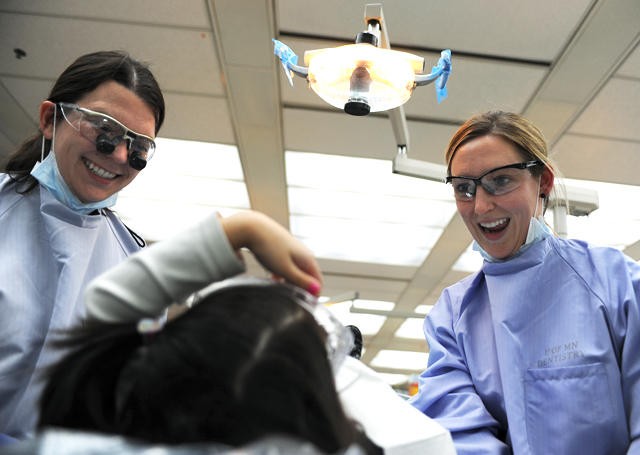When 16-year-old Bria Jones emerged in the waiting room after having a cavity filled, her mother, Copper Oya, expressed a mixture of gratitude and relief. âÄúIt brings peace of mind,âÄù said the 38-year-old Northeast Minneapolis resident, whose job through a temp agency doesnâÄôt pay enough to afford insurance. âÄúIt came at a good time.âÄù The family was one of many gathered at the University of Minnesota on Saturday to receive free care from about 250 dental students, faculty and staff as part of Give Kids a Smile Day, a nationwide event sponsored by the American Dental Association. All told, 140 children received care âÄî up from 107 last year âÄî some of whom had never been to a dentist before. The sixth floor of Moos Tower was an energetic swarm of parents, kids and sky-blue dental scrubs. The dental work, performed mostly by third- and fourth-year students, took place in a large, open room, with parents generally staying in the waiting room. âÄúI get a sense from the parents, some in particular, you can tell they just donâÄôt have a lot,âÄù Patrick Lloyd, dean of the School of Dentistry, said. âÄúFor whatever reason, they havenâÄôt been dealt the best hand. I think they come here and value what weâÄôre doing.âÄù The amount of dental work performed this year likely exceeded last yearâÄôs, which was valued at more than $60,000. Procedures included cavity fillings, fluoride treatments, cleanings, sealants, X-rays and extractions. All the procedures were done free of charge. A number of patients had tooth decay, which is the most common chronic disease among children and adolescents ages 6 to 19. The disease is four times more common than asthma among 14- to 17-year-olds and is known to cause tooth pain, fractured teeth, difficulty eating and in severe cases, death from an abscessed tooth. The underlying goal of the event was to inspire dental students to give back to the less fortunate when they are in practice, third-year dental student Brian Peters said. âÄúMost of it is just getting that public service message out that there is a need out there and itâÄôs important that we all do it,âÄù he said. With new estimates showing that nearly one in 10 Minnesotans didnâÄôt have health insurance last year, families are even less likely to have dental coverage. Among those who donâÄôt have insurance, only about half have been to the dentist in the past year, Dan Shaw, associate professor of pediatric dentistry, said. âÄúIf the family is struggling financially, itâÄôs something they might pretty readily put on the back burner,âÄù he said. Publicly funded assistance programs like MinnesotaCare cover the basics such as fillings, X-rays and cleanings, yet about one-third of Minnesota dentists donâÄôt accept such plans because the reimbursement rates donâÄôt cover the cost of providing care. Often, dentists that do accept such plans need to limit the number of patients they see to stay afloat. Under those programs, the clinic typically receives one-third the compensation the average patient would pay, yet every clinic still operates under fairly high fixed costs for staff, materials and rent, Dick Diercks, executive director of the Minnesota Dental Association, said. At next yearâÄôs event, Shaw said he hopes to bring in representatives from Hennepin County to connect families with assistance programs. Many of the people he saw had no insurance and would likely qualify for such programs. This was the UniversityâÄôs sixth annual GKAS day, although itâÄôs been going on at state and national levels for eight years. Through the event, about 7,000 children in Minnesota and 320,000 in the United States receive free dental care. In Minnesota alone, the services are valued at $1.7 million. As she looked around the waiting room, Oya said she was surprised she didnâÄôt see more people and guessed that many didnâÄôt know about the event. Kim Williams, a 45-year-old uninsured stay-at-home mom, brought her 16-year-old daughter Brittani. Although sheâÄôs been going to the University for her dental care for the past five years âÄî where services cost about 40 percent less than at private clinics âÄî she just learned about GKAS a few weeks ago. âÄúMy oldest is 19, and if I would have known about this, I wouldâÄôve come years ago,âÄù she said.

Image by Marija Majerle
Dental students Kacie Woodis, left, and Megan Mulligan, right, prepare Andrea Schyumn, 5, for an X-ray during Give Kids a Smile Day at Moos Tower on Saturday. The event, which is aimed at providing free dental care to children of low-income families, is practiced annually at clinics all over the country.
U volunteers Give Kids a Smile
Dental students, faculty and staff participated in the American Dental Association’s Give Kids a Smile Day.
by Tara Bannow
Published February 7, 2010
0

